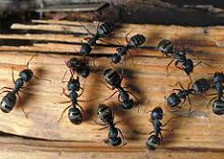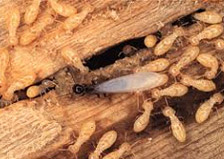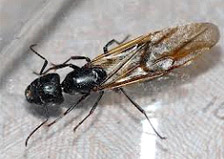

Loading content
Here in Massachusetts, Carpenter Ants (Camponotus), often called “Black Ants”, typically excavate tunnels in wood that is moist or has been wet in the past.
Unlike Termites that actually eat the wood as a food source, Carpenter Ants are only tunneling into wood to house their ant colony. Unfortunately this tunneling can cause serious damage to wood.
Ants can enter buildings through small gaps around doors and windows, utility and pipe penetrations, behind siding and trim or through rotted or damaged wood.
These black ants will also crawl along overhead wires, shrubs and tree limbs that touch the building. Even branches high above the ground can allow the Carpenter Ants to access.
Carpenter ants build nests in tree stumps, fence posts, firewood, landscaping, insulation or anywhere moisture is present. A colony can have multiple nests inside structures as well as outdoors. Carpenter Ants need a constant source of moisture to survive.
A quality ant exterminator is able to locate nesting sites and treat the ant colony directly. Specialized equipment is used to inject treatment materials deeper into voids, cracks and crevices, where the ants like to hide.


In early spring, homeowners often find large black ants with wings around the structure. These winged reproductive ants are known commonly as Ant Swarmers.
These swarming ants are future ant queens that are looking to establish their own colony. If you find large black ants or Carpenter Ants with wings, there is likely a nest within the structure or close by.
Carpenter Ants over-winter in their main colony nests. They don’t truly hibernate like some pest species. In colder months the ants do go into a dormant inactive period.






Trustindex verifies that the original source of the review is Google. These guys were incredible! I called for an ant infestation in my house and they came out the very next day and were able to get rid of the problem in time for when i had guests staying at my house that weekend. Highly recommend! Very professional, friendly, and know what they are doing. I'll be using them forever should any problem happen again.Trustindex verifies that the original source of the review is Google. Ultra Safe was very prompt and up front about my Wasp issue within my home. They came back when the weather was ideal for treatment rather than applying it when it was originally schedule in rainy conditions. They checked my property thoroughly and are very fairly priced in comparison to other quotes that were 5x the price in one instance, I would recommend them and will use them first in the future for any issues we have.Trustindex verifies that the original source of the review is Google. Ultra Safe Pest performed a termite inspection for me. They were quick to make an appointment with and very accommodating with the VA requirements for documentation.Trustindex verifies that the original source of the review is Google. The young man was professional , infomative and thorough .Trustindex verifies that the original source of the review is Google. John from USPM is helping us with an animal issue in our attic. We already feel relieved! John is very knowledgeable and experienced and is also kind and lovely to work with.Trustindex verifies that the original source of the review is Google. Collis is very knowledgeable and helpful giving tips for mice proofing. We have a challenging situation because the house old. Hopefully with the second follow-up visit, we can get rid of the mice that are nesting inside.Trustindex verifies that the original source of the review is Google. I setup to have Ultra Safe come to my property to assess where the animals were getting into the house.The wildlife tech Eric determined access was in one corner. There were multiple traps placed close to that spot. Over the course of 3 days the animals were trapped and removed. The hole was closed up with metal flashing put over it. The work was done in a professional manner and I am very happy with the results.Trustindex verifies that the original source of the review is Google. Easy to book and transparent about costs and services. Appreciated the practical advice and recommendations.Verified by TrustindexTrustindex verified badge is the Universal Symbol of Trust. Only the greatest companies can get the verified badge who has a review score above 4.5, based on customer reviews over the past 12 months. Read more